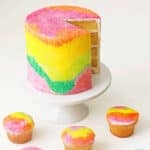
Sand Art Cake
how to make a 90s-inspired sand art cake using vanilla cake and colorful sugar.
Ingredients
for the cake:
- 1 box vanilla cake mix or vanilla cake recipe
- 6 cups organic cane sugar
- gel food coloring
for the buttercream frosting:
- 2 cups butter unsalted
- 2 cups sugar powdered
- 1 tbsp vanilla extract
Instructions
- Prepare your cake mix according to your recipe of choice. Whether it’s your own secret recipe or just a simple box mix, make sure that it is around the standard size of 12 cake servings. Once it’s mixed and ready to bake, divide the batter amongst 6-inch (or smaller) cake pans and bake at 350°F for 20 – 25 minutes until a toothpick inserted in the center of the cakes comes out clean. Let the cakes cool to room temperature.
- While the cakes are cooling, prepare your buttercream. In a large bowl or bowl of your stand mixer, beat the butter on low speed for 1 minute. Gradually add in the powdered sugar and vanilla extract, and beat until smooth. You may notice that this buttercream recipe has a higher ratio of butter to sugar than normal – this takes into account the sugar we’ll be adding later, so don’t worry if the taste isn’t as sweet as you’re used to it being!
- Once the cakes have cooled, first level each round using a serrated knife. To assemble, place your first cake (the bottom layer) on a cardboard cake round, add a layer of the buttercream frosting, and then position the next cake round on top. Repeat until all of your layers have been added, then use a spatula to frost the exterior of the cake, smoothing the sides of the cake. If the cakes look a little messy, you’re on the right track…this is the crumb coat, and it definitely shouldn’t look pretty! Refrigerate the cake for at least 1 hour to allow the crumb coat of frosting to set. Once the cake is firm to the touch, add on a thick, second layer of frosting to the cake. Again, smooth it with a spatula and put in back in the refrigerator. This second coat should look much prettier and be a smooth, white coat.
- While your cake is setting, prepare your colored sugars (the “sand” for the outside of your cake). Pick out a palette of your choice, sourcing each of your desired colors in gel food coloring form. You can use liquid food coloring if you want, but I find that gel coloring results in a much more vivid color and also doesn’t break down the sugar as easily. And believe me, I (Alana) have done a lot of comparative experiments between the two!
- For each desired color, place 1 cup of organic cane sugar in a seal-able bowl or bag. Add 1-2 drops of gel food coloring and mix the coloring into the sugar using a spoon. Seal the container (or bag) and shake vigorously until the color is thoroughly mixed into the sugar.
- Line a baking sheet with parchment paper. Evenly pour the colored sugar onto the sheet and use a rolling pin to break up any clumps. Bake at 120°F for 10 minutes. If your oven doesn’t go that low, just make sure it’s below 200°F.Once baked, set aside to cool and then go over the sugar with a rolling pin once more to break up any additional clumps that may have formed.
- Layout your sugar onto a contained work surface (preferably a large baking sheet covered with a sheet of parchment) in a wave pattern.
- Roll up a strip of parchment paper and gently move it over the sugar display to make all of the various colors of sugar level. The parchment roll works great as it’s lightweight, which is essential because you want the sugar to be loose and not compacted. Just make sure not to apply too much pressure when leveling.
- Once the second layer of frosting is firm, remove the cake from the refrigerator and use a pair of scissors to cut the cardboard cake round around the base, so that it is even with the edge of the cake. Use a spatula to transfer the cake to the freezer and set your timer for 15 minutes. It’s important that you don’t leave the cake in the freezer for longer than that, as it will start to freeze and create major condensation after that period…which would not work well with all the sugar it’s going to be rolled in! Typically, you’d have to leave a cake in the refrigerator for at least 4 hours for the frosting to get as firm as we need it, but this little 15 minute freezer trick is a great alternative!
- Once the 15 minutes have passed, remove the cake from the freezer and slowly roll it in the sugar mixture. Make sure not to overlap your starting point, as you don’t want the colors to mix.
- Place the cake on a plate or stand, adding a little buttercream between the cardboard base and surface to secure the cake in place.Finish off the design on the top of the cake, pouring the sugar directly onto the cake by hand. Gently use the backside of a spoon or a spatula to level the sugar.
Notes
If you’re feeling adventurous and want to decorate some cupcakes, now is your time to shine! Just turn frosted cupcakes (or cookies!) upside down into the leftover sugar design before you put it away to be stored.
Once you’ve decorated all the frosted desserts your heart can handle, section out the residual sugar by color as best as you can before separating it into bowls or glass containers to store.